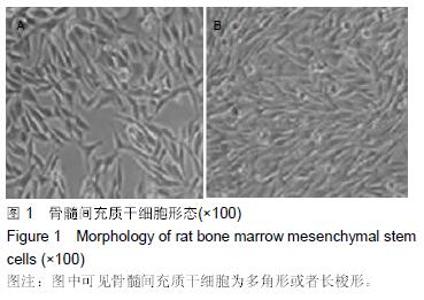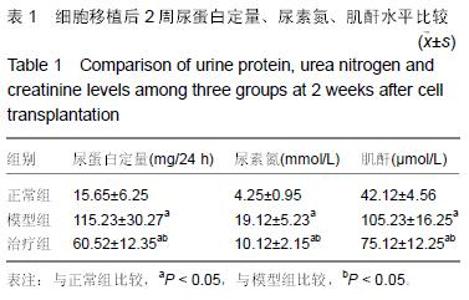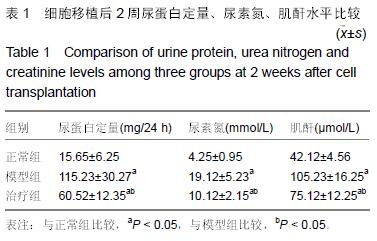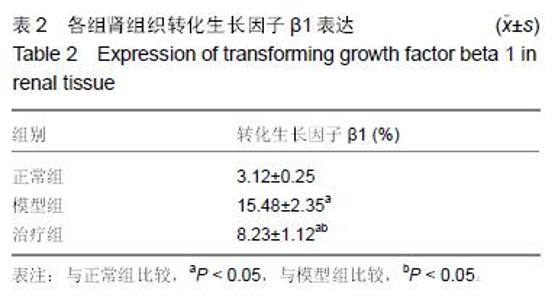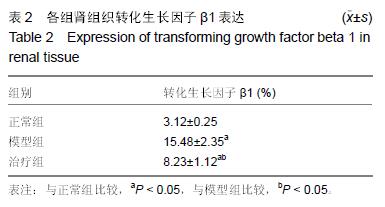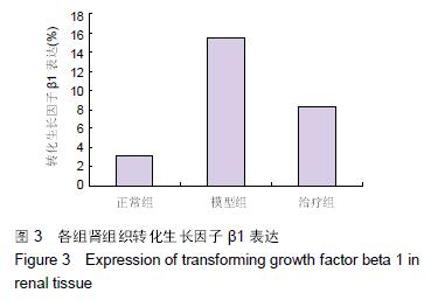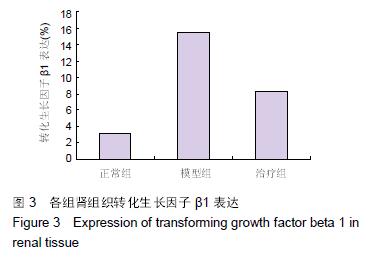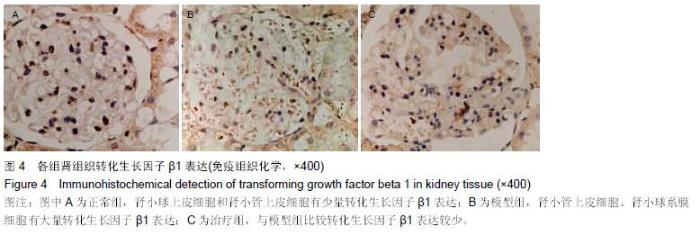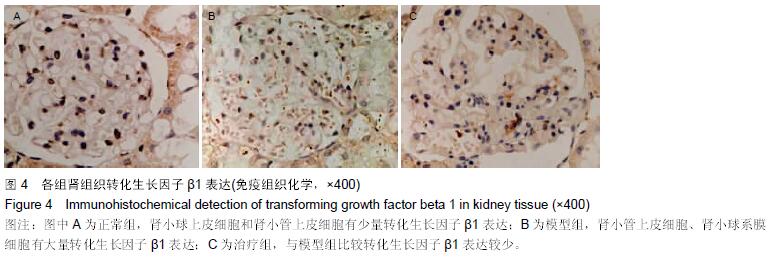Chinese Journal of Tissue Engineering Research ›› 2016, Vol. 20 ›› Issue (14): 2015-2020.doi: 10.3969/j.issn.2095-4344.2016.14.005
Previous Articles Next Articles
Bone marrow mesenchymal stem cell transplantation for repair of mesangial proliferative glomerulonephritis: role and mechanism
Liao Dan1, Zhang Lin1, Dai Xiao-yu1, Wang Jia-li1, Du Xiao-jiong2
- 1Department of Nephrology, Mianyang Central Hospital, Mianyang 621000, Sichuan Province, China; 2Department of Vascular Surgery, West China Hospital of Sichuan University, Chengdu 610041, Sichuan Province, China
-
Received:2016-03-01Online:2016-04-01Published:2016-04-01 -
About author:Liao Dan, Master, Attending physician, Department of Nephrology, Mianyang Central Hospital, Mianyang 621000, Sichuan Province, China -
Supported by:the Scientific Research Project of Sichuan Provincial Health Department, No. 120305
Cite this article
Liao Dan, Zhang Lin, Dai Xiao-yu, Wang Jia-li, Du Xiao-jiong. Bone marrow mesenchymal stem cell transplantation for repair of mesangial proliferative glomerulonephritis: role and mechanism[J]. Chinese Journal of Tissue Engineering Research, 2016, 20(14): 2015-2020.
share this article
| [1] 邹杰,冯江敏,李维,等.骨髓间充质干细胞在慢性马兜铃酸肾病大鼠肾脏中向肾小管周毛细血管丛内皮细胞的分化[J].中华医学杂志,2008,88(10):705-710. [2] 张蕊,任野平,高秀海,等.骨髓间充质干细胞对系膜增生性肾炎的修复作用及机制探讨[J].哈尔滨医科大学学报, 2011,45(6):544-549. [3] 王曌华.骨髓间充质干细胞在狼疮肾炎治疗中的研究进展[J].国际泌尿系统杂志,2010,30(2):237-241. [4] 彭伟,刘郑荣,任昊,等.骨髓间充质干细胞促进大鼠IgA肾病修复[J].中华肾脏病杂志,2008,24(10):743-750. [5] 徐璐,廖德怀,陈正,等.肾移植中经移植肾动脉输注骨髓间充质干细胞3例报告[J].中国组织工程研究与临床康复, 2010,14(53):10049-10052. [6] 赵红梅,胡祥,李芳,等.骨髓间充质干细胞在肾脏疾病中的应用[J].中国组织工程研究与临床康复,2010,14(23): 4329-4332. [7] Chang JW, Hung SP, Wu HH, et al. Therapeutic effects of umbilical cord blood-derived mesenchymal stem cell transplantation in experimental lupus nephritis. Cell Transplant. 2011;20(2):245-257. [8] El Kossi MM, Haylor JL, Johnson TS, et al. Stem cell factor in a rat model of serum nephrotoxic nephritis. Nephron Exp Nephrol. 2008;108(1):e1-e10. [9] 金碧辉.骨髓间充质干细胞对系膜增生性肾小球肾炎的修复作用[D]. 哈尔滨:哈尔滨医科大学,2008. [10] 黄金棋.骨髓间充质干细胞治疗系统性红斑狼疮鼠机制及疗效评价[D]. 福州:福建医科大学,2010. [11] 董海芸.骨髓间充质干细胞移植在肾脏疾病防治中的应用[J].中国组织工程研究与临床康复,2007,11(50): 10146-10149. [12] 董旭.骨髓间充质干细胞对Thy1系膜增生性肾小球肾炎的作用[D]. 哈尔滨:哈尔滨医科大学,2008. [13] Terrier B, Delmas Y, Hummel A, et al. Post-allogeneic haematopoietic stem cell transplantation membranous nephropathy: clinical presentation, outcome and pathogenic aspects. Nephrol Dial Transplant. 2007; 22(5):1369-1376. [14] 卫静.BMP-7基因修饰骨髓间充质干细胞治疗IgA肾病的实验研究[D].重庆:第三军医大学,2008. [15] Zhang L, Li K, Liu X, et al. Repeated systemic administration of human adipose-derived stem cells attenuates overt diabetic nephropathy in rats.Stem Cells Dev. 2013;22(23):3074-3086. [16] 马晓蕾,顾志峰,黄静,等.异基因骨髓间充质干细胞移植抑制B细胞活化缓解狼疮肾炎[C].西安:第15次全国风湿病学学术会议论文集,2010:144-145. [17] 陈洁,张智,曾慧兰,等.骨髓间充质干细胞预处理脑死亡供鼠对移植肾的保护作用[J].中华器官移植杂志,2015, 36(6): 362-366. [18] Ma X, Che N, Gu Z, et al. Allogenic mesenchymal stem cell transplantation ameliorates nephritis in lupus mice via inhibition of B-cell activation. Cell Transplant. 2013; 22(12):2279-2290. [19] Zoja C, Garcia PB, Rota C, et al. Mesenchymal stem cell therapy promotes renal repair by limiting glomerular podocyte and progenitor cell dysfunction in adriamycin-induced nephropathy. Am J Physiol Renal Physiol. 2012;303(9):F1370-1381. [20] Liu H, Liu F, Peng Y, et al. Role of mast cells, stem cell factor and protease-activated receptor-2 in tubulointerstitial lesions in IgA nephropathy. Inflamm Res. 2010;59(7):551-559. [21] 吴岩.间充质干细胞治疗慢性间质性肾炎动物模型意义初探[D].沈阳:中国医科大学,2010. [22] Iwata Y, Wada T, Uchiyama A, et al. Remission of IgA nephropathy after allogeneic peripheral blood stem cell transplantation followed by immunosuppression for acute lymphocytic leukemia. Intern Med. 2006;45(22): 1291-1295. [23] Shaughnessy PJ, Ririe DW, Ornstein DL, et al. Graft failure in a patient with systemic lupus erythematosus (SLE) treated with high-dose immunosuppression and autologous stem cell rescue. Bone Marrow Transplant. 2001;27(2):221-224. [24] Marmont AM, Gualandi F, van Lint MT, et al. Long term complete remission of severe nephrotic syndrome secondary to diffuse global (IV-G) lupus nephritis following autologous, haematopoietic peripheral stem (CD34+) cell transplantation. Lupus. 2006;15(1):44-46. [25] Huang X, Qin W, Zhang M, et al. Detection of anti-PLA2R autoantibodies and IgG subclasses in post-allogeneic hematopoietic stem cell transplantation membranous nephropathy. Am J Med Sci. 2013;346(1): 32-37. [26] Navaneethan SD, Taylor J, Goldman B, et al. Anti-neutrophil cytoplasmic antibody associated crescentic IgA nephropathy in hematopoietic stem cell transplantation. Clin Nephrol. 2009;71(1):59-62. [27] Zenz T, Schlenk RF, Glatting G, et al. Bone marrow transplantation nephropathy after an intensified conditioning regimen with radioimmunotherapy and allogeneic stem cell transplantation. J Nucl Med. 2006; 47(2):278-286. [28] Wang S, Li Y, Zhao J, et al. Mesenchymal stem cells ameliorate podocyte injury and proteinuria in a type 1 diabetic nephropathy rat model. Biol Blood Marrow Transplant. 2013;19(4):538-546. [29] 刘仁华.造血干细胞联合间充质干细胞共移植治疗鼠系统性红斑狼疮的实验研究[D].湛江:广东医学院,2011. [30] Chang JW, Hung SP, Wu HH, et al. Therapeutic effects of umbilical cord blood-derived mesenchymal stem cell transplantation in experimental lupus nephritis. Cell Transplant. 2011;20(2):245-257. [31] 纳宁,黄正宇,洪良庆,等.输注重组GDNF过表达的间质干细胞改善肾毒性血清肾炎肾功能[J].中山大学学报:医学科学版,2011,32(5):600-605. [32] Huang ZY, Hong LQ, Na N, et al. Infusion of mesenchymal stem cells overexpressing GDNF ameliorates renal function in nephrotoxic serum nephritis. Cell Biochem Funct. 2012;30(2):139-144. [33] 景红,宋红梅,魏珉,等.骨髓干细胞在IgA肾病发病机制中的作用[J].国际儿科学杂志,2006,33(5):332-334. [34] 马之学,尹智炜,王丹云,等.干细胞移植治疗IgA肾病1例[J].临床荟萃,2010,25(23):2100. |
| [1] | Zhang Tongtong, Wang Zhonghua, Wen Jie, Song Yuxin, Liu Lin. Application of three-dimensional printing model in surgical resection and reconstruction of cervical tumor [J]. Chinese Journal of Tissue Engineering Research, 2021, 25(9): 1335-1339. |
| [2] | Hou Jingying, Yu Menglei, Guo Tianzhu, Long Huibao, Wu Hao. Hypoxia preconditioning promotes bone marrow mesenchymal stem cells survival and vascularization through the activation of HIF-1α/MALAT1/VEGFA pathway [J]. Chinese Journal of Tissue Engineering Research, 2021, 25(7): 985-990. |
| [3] | Liang Xueqi, Guo Lijiao, Chen Hejie, Wu Jie, Sun Yaqi, Xing Zhikun, Zou Hailiang, Chen Xueling, Wu Xiangwei. Alveolar echinococcosis protoscolices inhibits the differentiation of bone marrow mesenchymal stem cells into fibroblasts [J]. Chinese Journal of Tissue Engineering Research, 2021, 25(7): 996-1001. |
| [4] | Geng Yao, Yin Zhiliang, Li Xingping, Xiao Dongqin, Hou Weiguang. Role of hsa-miRNA-223-3p in regulating osteogenic differentiation of human bone marrow mesenchymal stem cells [J]. Chinese Journal of Tissue Engineering Research, 2021, 25(7): 1008-1013. |
| [5] | Lun Zhigang, Jin Jing, Wang Tianyan, Li Aimin. Effect of peroxiredoxin 6 on proliferation and differentiation of bone marrow mesenchymal stem cells into neural lineage in vitro [J]. Chinese Journal of Tissue Engineering Research, 2021, 25(7): 1014-1018. |
| [6] | Zhu Xuefen, Huang Cheng, Ding Jian, Dai Yongping, Liu Yuanbing, Le Lixiang, Wang Liangliang, Yang Jiandong. Mechanism of bone marrow mesenchymal stem cells differentiation into functional neurons induced by glial cell line derived neurotrophic factor [J]. Chinese Journal of Tissue Engineering Research, 2021, 25(7): 1019-1025. |
| [7] | Pei Lili, Sun Guicai, Wang Di. Salvianolic acid B inhibits oxidative damage of bone marrow mesenchymal stem cells and promotes differentiation into cardiomyocytes [J]. Chinese Journal of Tissue Engineering Research, 2021, 25(7): 1032-1036. |
| [8] | Wang Shiqi, Zhang Jinsheng. Effects of Chinese medicine on proliferation, differentiation and aging of bone marrow mesenchymal stem cells regulating ischemia-hypoxia microenvironment [J]. Chinese Journal of Tissue Engineering Research, 2021, 25(7): 1129-1134. |
| [9] | Zeng Yanhua, Hao Yanlei. In vitro culture and purification of Schwann cells: a systematic review [J]. Chinese Journal of Tissue Engineering Research, 2021, 25(7): 1135-1141. |
| [10] | Xu Dongzi, Zhang Ting, Ouyang Zhaolian. The global competitive situation of cardiac tissue engineering based on patent analysis [J]. Chinese Journal of Tissue Engineering Research, 2021, 25(5): 807-812. |
| [11] | Chen Junyi, Wang Ning, Peng Chengfei, Zhu Lunjing, Duan Jiangtao, Wang Ye, Bei Chaoyong. Decalcified bone matrix and lentivirus-mediated silencing of P75 neurotrophin receptor transfected bone marrow mesenchymal stem cells to construct tissue-engineered bone [J]. Chinese Journal of Tissue Engineering Research, 2021, 25(4): 510-515. |
| [12] | Wu Zijian, Hu Zhaoduan, Xie Youqiong, Wang Feng, Li Jia, Li Bocun, Cai Guowei, Peng Rui. Three-dimensional printing technology and bone tissue engineering research: literature metrology and visual analysis of research hotspots [J]. Chinese Journal of Tissue Engineering Research, 2021, 25(4): 564-569. |
| [13] | Chang Wenliao, Zhao Jie, Sun Xiaoliang, Wang Kun, Wu Guofeng, Zhou Jian, Li Shuxiang, Sun Han. Material selection, theoretical design and biomimetic function of artificial periosteum [J]. Chinese Journal of Tissue Engineering Research, 2021, 25(4): 600-606. |
| [14] | Liu Fei, Cui Yutao, Liu He. Advantages and problems of local antibiotic delivery system in the treatment of osteomyelitis [J]. Chinese Journal of Tissue Engineering Research, 2021, 25(4): 614-620. |
| [15] | Li Xiaozhuang, Duan Hao, Wang Weizhou, Tang Zhihong, Wang Yanghao, He Fei. Application of bone tissue engineering materials in the treatment of bone defect diseases in vivo [J]. Chinese Journal of Tissue Engineering Research, 2021, 25(4): 626-631. |
| Viewed | ||||||
|
Full text |
|
|||||
|
Abstract |
|
|||||
